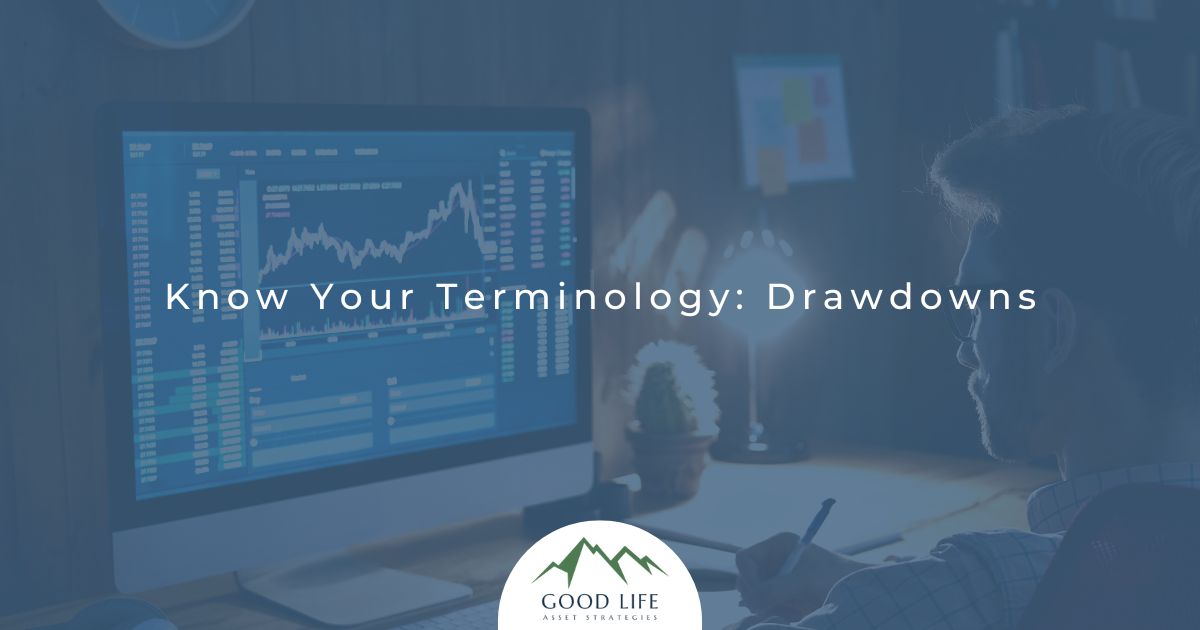- 817-864-8560
- justin@g-las.com
- Mon - Fri: 9:00am - 5:00pm

Thank you for returning for the fourth installment in our “Know Your Terminology” series, or if you are new, welcome. We’ve already discussed several types of investment types and their associated tools and strategies. Today I want to focus on one term you need to understand, “drawdowns.”
In investing, drawdowns refer to the decline in the value of an investment from its peak to its lowest point. It’s a measure of the loss an investor has incurred from the highest point of an investment to its lowest point. For example, suppose an investor purchased shares of a company at $100 per share, and the value of the shares increased to $120 per share. If the share price then declined to $80 per share, the drawdown for that investment would be 33.33% or $40 per share.
These declines can occur for various reasons, such as economic downturns, geopolitical tensions, company-specific issues, or natural disasters. The severity and duration can vary, depending on the underlying factors. In some cases, drawdowns can be short-lived (maybe just weeks or months), while in others, they can last for years.
Though no one likes talking about them, these are crucial measures of risk for investors, and they are often used to assess the performance of an investment portfolio. Investors use drawdowns to evaluate how much they stand to lose from an investment and to help them make informed investment decisions.
Understanding investing requires taking levels of risk. Every investment you make will have levels of risk and potential for drawdowns. As a rule of thumb, the more risk, the more reward (but don’t write that in stone). Just because a potential investment has experienced a decline doesn’t mean it should be discarded. Any potential decline simply needs to be weighed against the potential reward to see if the investment makes sense. For example, you may want to pass on a fund that has produced a 50% return over the past five years (roughly 10% per year) but has had a 40% drawdown during that same period. On the other hand, a fund that’s produced that same 50% over the past five years but has experienced just a 6% decline may be worth a look-see.
Understand that drawdowns are not the same as a loss. It only measures the decline in value from the peak of investment. Because of dividends, an investor may still have a positive return, even if a decline occurs in the investment’s value.
No one likes discussing this, so you might want to avoid broaching the subject in social settings. It’s like asking the host how much they paid for their house, or how much they weigh. But it should be one of the first things you inquire about before placing your hard-earned money in a fund or with an adviser. And if you hear anyone say they have never experienced a drawdown, run. Run as fast and as far away from them as humanly possible, because they are lying through their pearly white teeth.
If you’re ready to learn more about all things related to financial management and planning or if you aren’t happy with the performance of your current portfolio, reach out to us for a free consultation and no-obligation review.
The views expressed represent the opinion of Good Life Asset Strategies, LLC. The views are subject to change and are not intended as a forecast or guarantee of future results. This material is for informational purposes only. It does not constitute investment advice and is not intended as an endorsement of any specific investment. Stated information is derived from proprietary and nonproprietary sources that have not been independently verified for accuracy or completeness.
Good Life Asset Strategies, LLC is a registered investment advisor located in Fort Worth, Texas. Good Life Asset Strategies, LLC and its representatives are in compliance with the current registration and notice filing requirements imposed upon registered investment advisors by those states within which the firm maintains clients.
All information herein has been prepared solely for informational purposes, and it is not an offer to buy or sell, or a solicitation of an offer to buy or sell any security or instrument or to participate in any particular trading strategy. Such an offer can only be made in the states that Good Life Asset Strategies, LLC is either registered or a notice filer or an exemption from registration is available under the securities laws or other laws.
Certified Financial Planner Board of Standards, Inc. (CFP Board) owns the CFP® certification mark, the CERTIFIED FINANCIAL PLANNER™ certification mark, and the CFP® certification mark (with plaque design) logo in the United States, which it authorizes use of by individuals who successfully complete CFP Board’s initial and ongoing certification requirements.